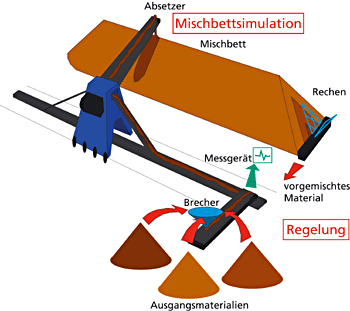Mix beds are used for the homogenization and mixing of large amounts of different granular materials, e. g., in cement industry. In cooperation with the department System Analysis, Prognosis and Control, there was developed software for the control and simulation of such mix beds was developed for the company MVT Mechanical and Process Engineering Bernhard Blatton Ltd.
The figure below shows the scheme of a modern mix bed. The different materials are transported from separate stocks onto a common transport belt, crushed in the crusher, examined online with respect to their chemical composition, and finally piled up on the mix bed by the stacker. The mixing effect results from the process of reclaiming the material in slices orthogonal to the stacked layers.
The objective is to control the feeding of material from the stocks in such a way that the composition of the reclaimed slices meets certain demands, e. g., remains within narrow limits around required values for time saturation factor and silicate module. Additionally, the simulation of the mix bed also determines how the premixed material is distributed across the stock and, finally, within the reclaimed slices. Hence, simulation must be included into control in order to solve the problem.

